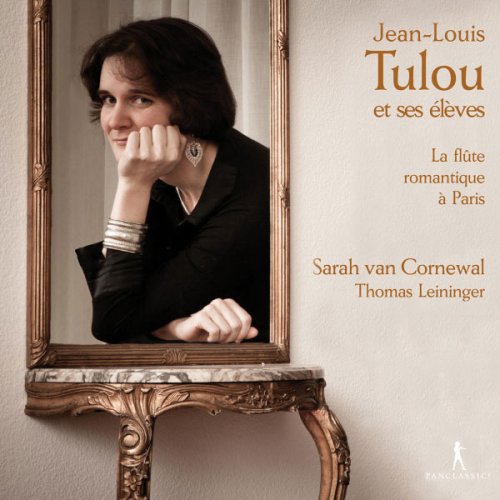
Sarah van Cornewal - Jean-Louis Tulou et ses élèves: La flûte romantique à Paris (2012)
BAND/ARTIST: Sarah van Cornewal
- Title: Jean-Louis Tulou et ses élèves: La flûte romantique à Paris
- Year Of Release: 2012
- Label: Pan Classics
- Genre: Classical
- Quality: flac lossless +Booklet
- Total Time: 01:18:22
- Total Size: 359 mb
- WebSite: Album Preview
Tracklist
---------
01. Petite fantaisie poetique
02. Bolero
03. Flute Sonata No. 2, Op. 23: I. Allegro vivace
04. Flute Sonata No. 2, Op. 23: II. Andante
05. Flute Sonata No. 2, Op. 23: III. Scherzo final
06. Etudes de salon: Etudes de salon: Le chant du vent (The Song of the Wind)
07. Elegie
08. Duo Concertant, Op. 72: I. Allegro moderato
09. Duo Concertant, Op. 72: II. Allegro appassionato
10. Le cafe du roi
11. Hommage a Tulou
12. Cavatine de la Zelmira
Three composers can be heard on this recording: Jean-Louis Tulou (1786-1865) and two of his students: Jules Demerssemann (1833-1866) and Jean Donjon (1821-1912). Tulou and Demerssemann left countless concertos and virtuosic solo pieces and between 1832 and 1860, every obligatory test piece for the yearly exam at the Paris Conservatoire was composed by Tulou.
These are not included here, instead, Pan Classics have chosen two types of piece: those composed for the music connoisseur, such as the 'Petite fantaisie poétique' or the 'Boléro' by Demerssemann; and those based on virtuosic opera arias, rewritten in 'simple' versions for flute and piano for performance in the Parisian salons, like Tulou's 'La Cavatine de Zelmira' (in effect, a piano concerto with flute accompaniment) or 'Le café du roi'. Demerssemann's 'L'hommage à Tulou' ends in wild variations that contrast with the beautiful, unpretentious melodic lines, which fit Godfroy's flute well. Tulou's 'Duo Concertant' op. 72 for two flutes mixes light music with serious passages that betray the influence of Beethoven. In the score of Demerssemann's Deuxième Sonate op. 23, the tempi, character and nuances are indicated with great precision, thus providing fascinating evidence for interpretation and playing style at that time, even if simultaneously restricting modernday artistic expression. Lastly, we have the 'Etudes de salon et solos ou caprices pour la flûte seule' by Jean Donjon, an advocate of the new Boehm flute and therefore a representative of the transition into the new era.
In addition to the musical concerns which governed the selection of the repertoire, these works are interpreted on historical instruments. Historical fingering charts preserved in contemporary flute tutors were also instructive.
---------
01. Petite fantaisie poetique
02. Bolero
03. Flute Sonata No. 2, Op. 23: I. Allegro vivace
04. Flute Sonata No. 2, Op. 23: II. Andante
05. Flute Sonata No. 2, Op. 23: III. Scherzo final
06. Etudes de salon: Etudes de salon: Le chant du vent (The Song of the Wind)
07. Elegie
08. Duo Concertant, Op. 72: I. Allegro moderato
09. Duo Concertant, Op. 72: II. Allegro appassionato
10. Le cafe du roi
11. Hommage a Tulou
12. Cavatine de la Zelmira
Three composers can be heard on this recording: Jean-Louis Tulou (1786-1865) and two of his students: Jules Demerssemann (1833-1866) and Jean Donjon (1821-1912). Tulou and Demerssemann left countless concertos and virtuosic solo pieces and between 1832 and 1860, every obligatory test piece for the yearly exam at the Paris Conservatoire was composed by Tulou.
These are not included here, instead, Pan Classics have chosen two types of piece: those composed for the music connoisseur, such as the 'Petite fantaisie poétique' or the 'Boléro' by Demerssemann; and those based on virtuosic opera arias, rewritten in 'simple' versions for flute and piano for performance in the Parisian salons, like Tulou's 'La Cavatine de Zelmira' (in effect, a piano concerto with flute accompaniment) or 'Le café du roi'. Demerssemann's 'L'hommage à Tulou' ends in wild variations that contrast with the beautiful, unpretentious melodic lines, which fit Godfroy's flute well. Tulou's 'Duo Concertant' op. 72 for two flutes mixes light music with serious passages that betray the influence of Beethoven. In the score of Demerssemann's Deuxième Sonate op. 23, the tempi, character and nuances are indicated with great precision, thus providing fascinating evidence for interpretation and playing style at that time, even if simultaneously restricting modernday artistic expression. Lastly, we have the 'Etudes de salon et solos ou caprices pour la flûte seule' by Jean Donjon, an advocate of the new Boehm flute and therefore a representative of the transition into the new era.
In addition to the musical concerns which governed the selection of the repertoire, these works are interpreted on historical instruments. Historical fingering charts preserved in contemporary flute tutors were also instructive.
As a ISRA.CLOUD's PREMIUM member you will have the following benefits:
- Unlimited high speed downloads
- Download directly without waiting time
- Unlimited parallel downloads
- Support for download accelerators
- No advertising
- Resume broken downloads


